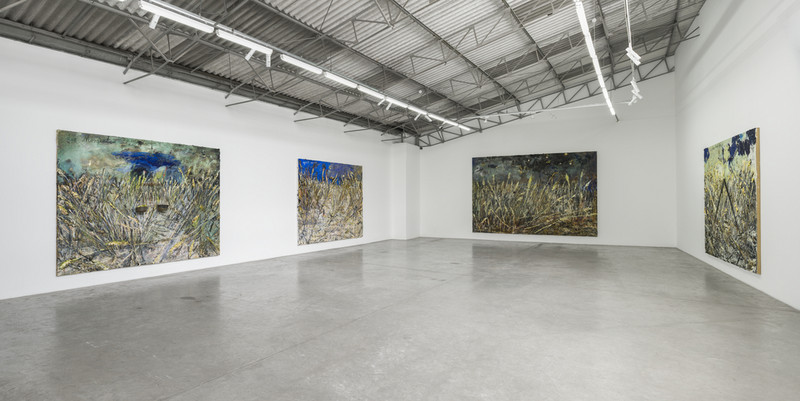Anselm Kiefer
07 Apr - 20 Jun 2015
ANSELM KIEFER
Paintings
7 April – 20 June 2015
White Cube São Paulo is pleased to present an exhibition of recent work by Anselm Kiefer. The paintings in this exhibition explore themes of history, politics and landscape and, in particular, the vision of ‘The Morgenthau Plan’.
‘The Morgenthau Plan’, proposed in 1944 by United States Treasury Secretary Henry Morgenthau, Jr., was conceived to transform post-war Germany into a pre-industrial, agricultural nation in order to limit its ability to wage war. A polarising political act that in the artist’s words ‘ignored the complexity of things’, it sought to divide Germany into two independent states, annexing or dismantling all German centres of industry. Although ‘The Morgenthau Plan’ was never realised in its original form, it represented an alternative rural future, whereby the country would potentially be occupied more by farmland and plant-life than industry.
In this exhibition, Kiefer returns to the depiction of rural landscape and to one of his key symbols, flowers blooming through destruction and devastation. In these canvases, which echo both German Romantic painting and the turbulent landscapes of Van Gogh, huge, dark expanses of plant life – wheat or flowers – dominate two-thirds of the painting’s composition. Fertile and abundant and painted en masse, the plants are beginning to topple and decay, pictured from a perspective deep within their midst.
The notion of transformation and the alchemical has always been central to the artist’s practice and here Kiefer combines thick impasto layers of acrylic paint with metal, salt and electrolysed sediment to create unfixed surfaces, which physically change during the course of the painting’s existence. In one picture entitled Morgenthau – Plan: Saeculum Aureum (2014), an explosion of trampled and decaying purple and green vegetation is set against a stretch of golden sky, created by covering the top section of canvas with gold leaf, while in others, green copper sulphate suggests areas of dense cloud or pockets of organic decay. Kiefer’s singular approach to materials, clearly visible in these works, enacts an artistic alchemy creating experimental, playful and dynamic surfaces that are constantly in flux.
‘The Morgenthau Plan’ works present a cyclical view of past and future, part of a reflective process that addresses the fundamental absurdity of politics and the inherent power of landscape, exploiting the acute contradiction between the beauty of a rural, pre-industrial landscape and the destruction of an economic future that it represents.
Paintings
7 April – 20 June 2015
White Cube São Paulo is pleased to present an exhibition of recent work by Anselm Kiefer. The paintings in this exhibition explore themes of history, politics and landscape and, in particular, the vision of ‘The Morgenthau Plan’.
‘The Morgenthau Plan’, proposed in 1944 by United States Treasury Secretary Henry Morgenthau, Jr., was conceived to transform post-war Germany into a pre-industrial, agricultural nation in order to limit its ability to wage war. A polarising political act that in the artist’s words ‘ignored the complexity of things’, it sought to divide Germany into two independent states, annexing or dismantling all German centres of industry. Although ‘The Morgenthau Plan’ was never realised in its original form, it represented an alternative rural future, whereby the country would potentially be occupied more by farmland and plant-life than industry.
In this exhibition, Kiefer returns to the depiction of rural landscape and to one of his key symbols, flowers blooming through destruction and devastation. In these canvases, which echo both German Romantic painting and the turbulent landscapes of Van Gogh, huge, dark expanses of plant life – wheat or flowers – dominate two-thirds of the painting’s composition. Fertile and abundant and painted en masse, the plants are beginning to topple and decay, pictured from a perspective deep within their midst.
The notion of transformation and the alchemical has always been central to the artist’s practice and here Kiefer combines thick impasto layers of acrylic paint with metal, salt and electrolysed sediment to create unfixed surfaces, which physically change during the course of the painting’s existence. In one picture entitled Morgenthau – Plan: Saeculum Aureum (2014), an explosion of trampled and decaying purple and green vegetation is set against a stretch of golden sky, created by covering the top section of canvas with gold leaf, while in others, green copper sulphate suggests areas of dense cloud or pockets of organic decay. Kiefer’s singular approach to materials, clearly visible in these works, enacts an artistic alchemy creating experimental, playful and dynamic surfaces that are constantly in flux.
‘The Morgenthau Plan’ works present a cyclical view of past and future, part of a reflective process that addresses the fundamental absurdity of politics and the inherent power of landscape, exploiting the acute contradiction between the beauty of a rural, pre-industrial landscape and the destruction of an economic future that it represents.

